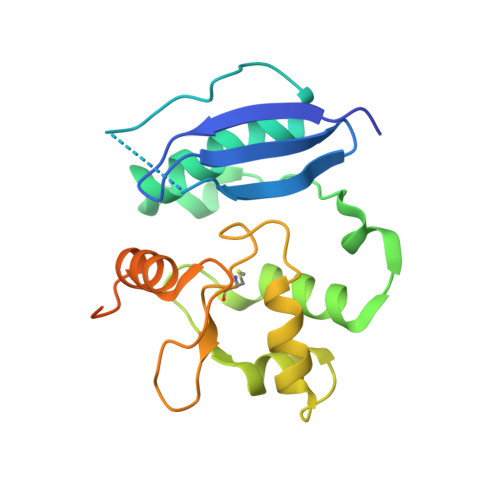Active and alkylated human AGT structures: a novel zinc site, inhibitor and extrahelical base binding.
Daniels, D.S., Mol, C.D., Arvai, A.S., Kanugula, S., Pegg, A.E., Tainer, J.A.(2000) EMBO J 19: 1719-1730
- PubMed: 10747039
- DOI: https://doi.org/10.1093/emboj/19.7.1719
- Primary Citation of Related Structures:
1EH6, 1EH7, 1EH8 - PubMed Abstract:
Human O(6)-alkylguanine-DNA alkyltransferase (AGT), which directly reverses endogenous alkylation at the O(6)-position of guanine, confers resistance to alkylation chemotherapies and is therefore an active anticancer drug target. Crystal structures of active human AGT and its biologically and therapeutically relevant methylated and benzylated product complexes reveal an unexpected zinc-stabilized helical bridge joining a two-domain alpha/beta structure. An asparagine hinge couples the active site motif to a helix-turn-helix (HTH) motif implicated in DNA binding. The reactive cysteine environment, its position within a groove adjacent to the alkyl-binding cavity and mutational analyses characterize DNA-damage recognition and inhibitor specificity, support a structure-based dealkylation mechanism and suggest a molecular basis for destabilization of the alkylated protein. These results support damaged nucleotide flipping facilitated by an arginine finger within the HTH motif to stabilize the extrahelical O(6)-alkylguanine without the protein conformational change originally proposed from the empty Ada structure. Cysteine alkylation sterically shifts the HTH recognition helix to evidently mechanistically couple release of repaired DNA to an opening of the protein fold to promote the biological turnover of the alkylated protein.
Organizational Affiliation:
The Skaggs Institute for Chemical Biology, Department of Molecular Biology, MB-4, The Scripps Research Institute, 10550 North Torrey Pines Road, La Jolla, CA 92037-1027, USA.
















